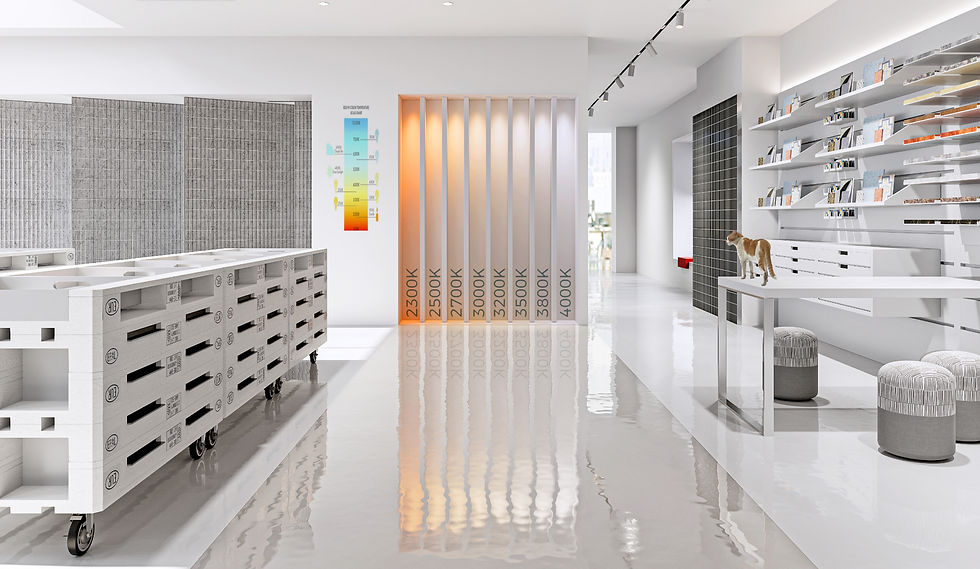The Importance of Light in Interior Design: Understanding Color Temperatures for Your Spaces
- NEXUS Media
- Aug 24
- 4 min read
Light is not just about visibility; it is a powerful tool in interior design. The right lighting can change how a space feels and functions. From brightening a room to creating a warm, welcoming atmosphere, light plays a pivotal role. If you understand color temperatures and how they affect your spaces, you can craft the ideal ambiance for any room. In this post, we will explore the significance of light in interior design and look into different color temperatures that can enhance your living and working environments.
The Role of Light in Interior Design
Light serves several essential functions in interior design. It highlights architectural features and creates focal points, shaping our perception of space. For example, natural light can make a small room feel more spacious, while strategically placed lights can draw attention to artwork or unique design elements. Research shows that a well-lit environment can boost mood and productivity by up to 20%.
It is important to consider how light interacts with colors and materials. The right type of lighting can enhance textures and colors, making them pop. Conversely, poor lighting can wash out your design choices. For any designer or homeowner, mastering the use of light is paramount.
Understanding Color Temperature
Color temperature, measured in Kelvin (K), defines the warmth or coolness of a light source. It ranges from warm yellow tones to cool blue tones. The choices you make regarding color temperature can significantly impact the mood of a room. Here are the main categories of color temperatures:
Warm White (2700K - 3000K): This range creates a cozy, inviting atmosphere, making it perfect for relaxation areas like living rooms and bedrooms. About 80% of homeowners prefer this warm tone for their bedrooms due to its comforting effect.
Neutral White (3500K - 4100K): This balanced light suits spaces like kitchens and bathrooms, where clarity is necessary. It helps showcase colors accurately, which is crucial in cooking or personal grooming.
Cool White (5000K - 6500K): Mimicking daylight, this light is perfect for workspaces where focus and concentration are key. Studies suggest that a well-lit office with cooler tones can enhance work performance by 10% or more.

Warm White Light: Creating Cozy Spaces
Warm white light is ideal for crafting inviting and comfortable settings. It shines brilliantly in residential areas, especially living rooms and bedrooms, enhancing warm colors like reds and yellows. Imagine a family gathering in a softly lit living room—this type of lighting fosters connection and comfort.
Consider incorporating dimmable fixtures to customize the brightness. For example, in the evening, you might lower the lights to create a relaxed atmosphere while brighter lighting during the day can make your space feel lively. By adjusting the light throughout the day, you can create the perfect mood at any time.

Neutral White Light: Versatility in Design
Neutral white light finds a comfortable middle ground between warm and cool, making it a versatile option. It works wonders in kitchens and bathrooms, where bright, clear light is vital for tasks. For instance, accurate lighting in the kitchen ensures you can see the true colors of ingredients, leading to better meal presentation and preparation.
This color temperature enhances the appearance of colors without distortion, making it perfect for areas where looks matter. Installing LED lights in this range in kitchens can create a bright, inviting area that encourages culinary creativity.
Cool White Light: Enhancing Focus and Productivity
Cool white light mimics daylight and is best used in settings that require higher focus levels. Commonly found in offices and study areas, this type of lighting can help reduce fatigue and enhance concentration. Studies show that environments lit with cooler tones can bolster productivity, making it easier to accomplish tasks efficiently.
To maximize this effect, use cool white light in task areas. For instance, a workspace could feature cool white task lighting above the desk while warm lighting in adjacent areas provides comfort. This mix creates an environment conducive to both focus and relaxation.

The Impact of Natural Light
While artificial lighting is essential, natural light is a game-changer in interior design. It can make spaces feel more open and airy. When designing a room, assess how natural light flows into the area and explore ways to enhance it.
Consider adding large windows or skylights to maximize natural light. Opening up floor plans can also encourage light to fill the room. Moreover, using reflective materials, like mirrors and light-colored walls, can further amplify brightness. For example, adding a mirror opposite a window can increase the light in a room by 30%.
Layering Light for Optimal Design
An effective strategy in interior design is the layering of light. This involves integrating different types of lighting—ambient, task, and accent—to create a well-rounded and functional space.
Ambient Lighting: This is the general light that fills a room, achieved through ceiling fixtures and wall sconces. It serves as the foundation of room illumination.
Task Lighting: This focuses on areas where specific activities occur, such as reading or cooking. Examples include desk lamps and under-cabinet lights.
By thoughtfully combining these types of lighting, you create a dynamic environment that enhances mood and usability. The right mix can brighten your day-to-day life and elevate your overall design.
Choosing the Right Fixtures
Selecting quality fixtures is vital for achieving your desired lighting effect. Consider the style, size, and function of the fixtures carefully. For instance, a grand chandelier can create a stunning focal point in a dining room, while sleek pendant lights might better suit a contemporary kitchen.
Moreover, pay attention to energy efficiency. LED fixtures are an excellent choice due to their long lifespan and minimal energy use. They come in a variety of color temperatures, helping you match your lighting perfectly with the ambiance you want to create.
Final Thoughts on Light's Role in Design
In summary, light is a fundamental element of interior design that can greatly influence mood, usability, and aesthetics. By understanding color temperatures and their effects on your environment, you can craft spaces that are beautiful and functional.
Whether you're aiming to create a cozy living area with warm white light, a versatile kitchen with neutral tones, or a productive workspace with cool white lighting, your choices can positively impact your design. Remember to consider the role of natural light and the power of layered lighting. With thoughtful planning, you can create spaces that inspire and work well for you.



Light really is one of the most underrated elements in interior design, especially when it comes to choosing the right color temperatures for different spaces. The right balance can completely change how a room feels and functions.
If you’re looking for tailored guidance on lighting and design, I recommend checking out Draw Architecture https://draw-architecture.co.uk. They specialize in thoughtful architectural and interior solutions, ensuring that every element from natural light to artificial fixtures works in harmony with your space.